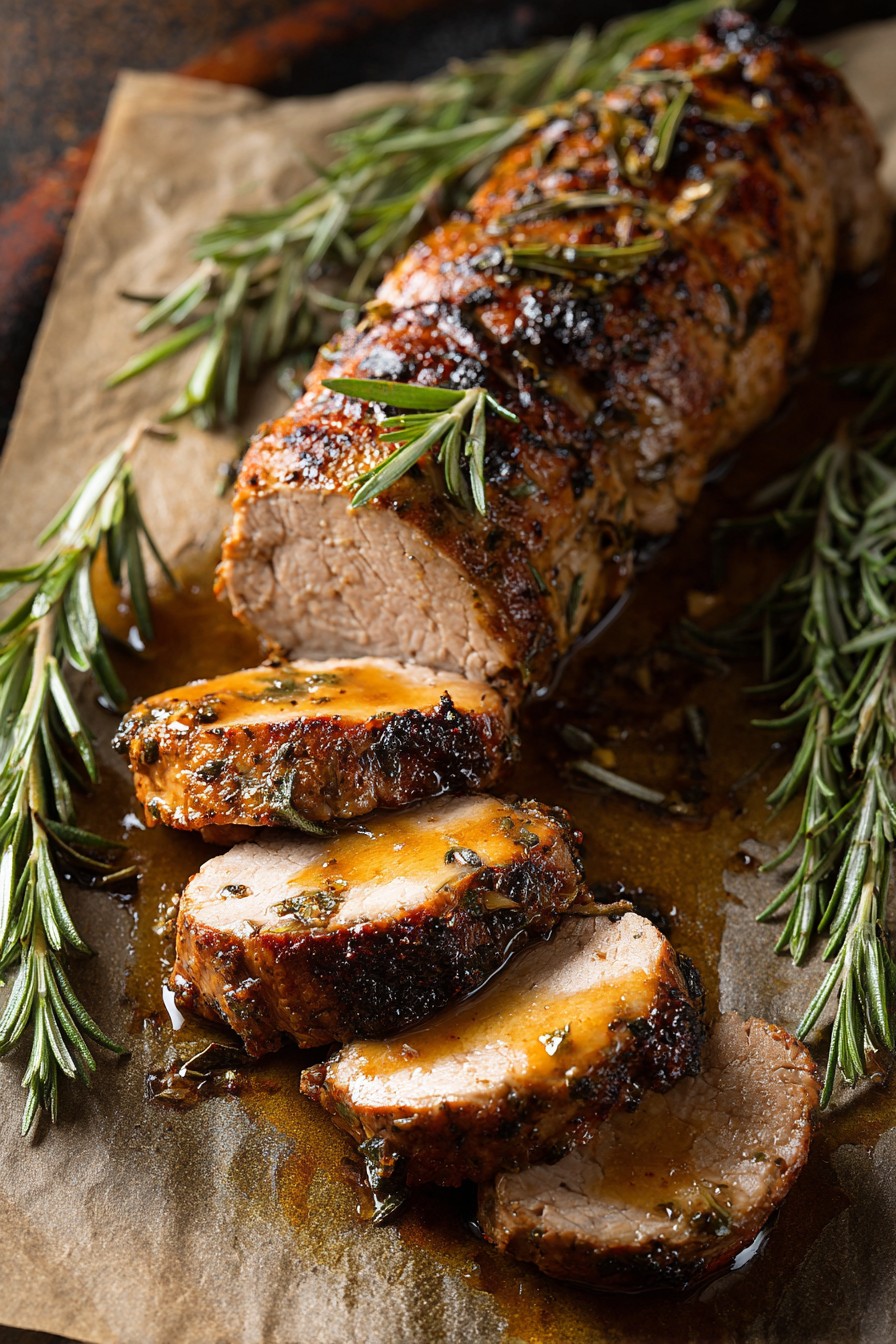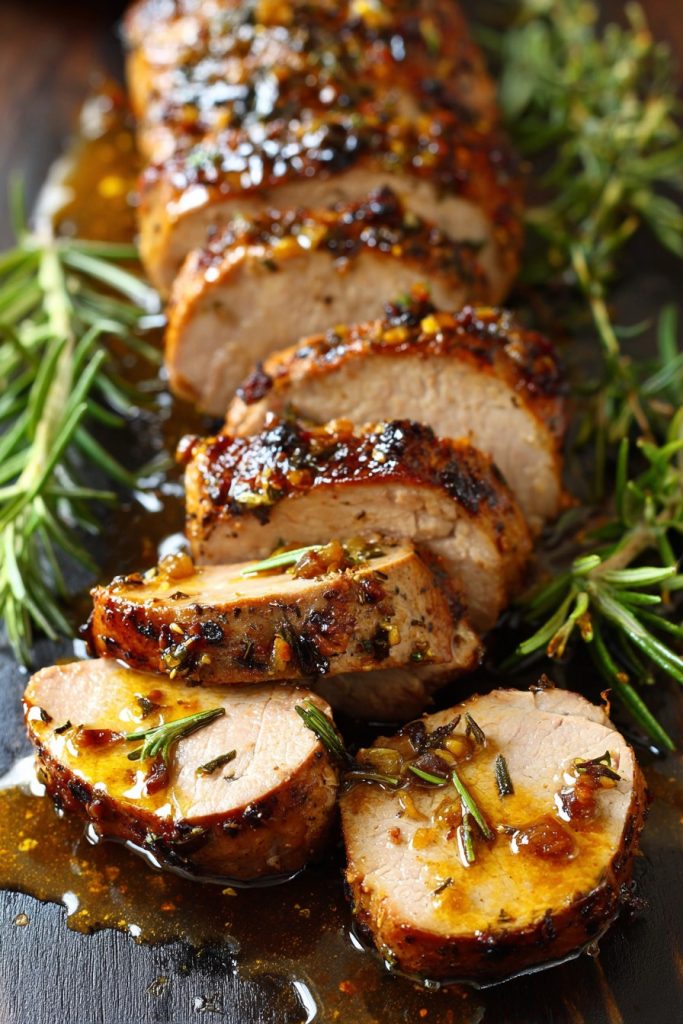Our hands brushed as we reached for the same wine glass, laughter floating between us like the delicate herbs infusing our evening. Only in these quiet moments, when the world outside fades to a gentle hum and the oven warms our kitchen with promises of shared delight, do we truly remember how food becomes the language of love. This pork tenderloin, with its tender embrace of flavors and elegant simplicity, transforms an ordinary evening into a memory woven with golden threads of connection and comfort.
Why This Recipe Works
- The gentle marinade of rosemary, garlic, and honey creates a symphony of flavors that penetrate deep into the pork’s delicate fibers, ensuring every bite carries the whispered secrets of herbs and the sweet promise of golden honey, much like how shared memories become woven into the fabric of a relationship.
- High-temperature roasting followed by resting allows the exterior to develop a beautifully caramelized crust while preserving the interior’s juicy tenderness, creating that perfect contrast between the crisp, flavorful outside and the meltingly soft inside that feels like coming home to warmth after a long day.
- Using a meat thermometer eliminates guesswork and guarantees perfect doneness every time, ensuring your romantic evening remains uninterrupted by culinary uncertainties, allowing you to focus on what truly matters—the connection blossoming between you and your beloved across the candlelit table.
- The simple pan sauce made from roasting drippings amplifies the natural flavors without overwhelming the pork’s delicate nature, creating a silky cascade of flavor that ties the entire dish together like the final, perfect note in a love song that lingers in the air long after the meal has ended.
Ingredients
- 1.5 pounds pork tenderloin, trimmed of silver skin
- 3 tablespoons olive oil, divided
- 4 cloves garlic, minced
- 2 tablespoons fresh rosemary, finely chopped
- 1 tablespoon honey
- 1 teaspoon Dijon mustard
- 1 teaspoon kosher salt
- ½ teaspoon freshly ground black pepper
- ½ cup chicken broth
- 2 tablespoons unsalted butter
- 1 tablespoon fresh lemon juice
Equipment Needed
- Large oven-safe skillet or roasting pan
- Instant-read meat thermometer
- Small mixing bowl
- Cutting board
- Sharp chef’s knife
- Measuring spoons
- Tongs
- Aluminum foil
Instructions

Prepare the Marinade and Coat the Pork
In a small bowl that feels cool against your fingertips, combine two tablespoons of olive oil with the minced garlic, letting the sharp fragrance of garlic mingle with the earthy scent of freshly chopped rosemary. Add the honey, watching as it cascades slowly into the mixture, followed by the Dijon mustard that adds just the right amount of gentle sharpness. Season this aromatic blend with kosher salt and freshly ground black pepper, then whisk everything together until the ingredients embrace each other completely. Pat the pork tenderloin dry with paper towels, removing any moisture that might prevent the beautiful browning we seek, then gently rub the marinade over every surface of the meat, massaging it with the same tender care you might show when holding your beloved’s hand. Let the pork rest at room temperature for thirty minutes, allowing the flavors to penetrate deep into the muscle fibers, transforming simple ingredients into an orchestra of taste waiting to be unleashed by the oven’s warmth.
Sear the Pork to Perfection
Preheat your oven to 425°F, that magical temperature where transformations occur and ordinary ingredients become extraordinary. Place your large oven-safe skillet over medium-high heat and add the remaining tablespoon of olive oil, watching as it shimmers and dances across the surface when properly heated. Carefully place the marinated pork tenderloin in the hot skillet, listening to that satisfying sizzle that promises delicious things to come. Sear for exactly two minutes on each side, using tongs to turn the pork until all surfaces develop a deep golden-brown crust that locks in the juices and creates those beautiful caramelized notes we cherish. Resist the temptation to move the pork during these initial minutes—this patience allows the Maillard reaction to work its magic, creating complex flavors that will make your dinner companion’s eyes light up with delight when they take that first, unforgettable bite.
Roast to Ideal Temperature
Transfer the skillet directly from the stovetop to the preheated oven, feeling the wave of warmth that greets you as you open the oven door. Roast the pork for 15-20 minutes, depending on the thickness of your tenderloin, but the true secret lies in using your instant-read meat thermometer. Insert the thermometer into the thickest part of the pork, waiting for that digital reading that takes the guesswork out of cooking and ensures perfection every time. Remove the pork from the oven when the internal temperature reaches 145°F for medium-rare or 150°F for medium—these temperatures guarantee a juicy, tender result that will melt in your mouth rather than becoming tough and dry. Transfer the pork to a clean cutting board and tent it loosely with aluminum foil, allowing the residual heat to continue cooking the meat gently while the juices redistribute throughout, creating that perfect texture we dream of in romantic dinners.
Create the Pan Sauce
While the pork rests, return the same skillet to medium heat on your stovetop, being careful of the hot handle that retains the oven’s warmth. Pour in the chicken broth, listening to the satisfying sizzle as it deglazes the pan and lifts all those beautiful browned bits from the bottom—these flavor-packed morsels are the secret to an extraordinary sauce. Use a wooden spoon to scrape the bottom thoroughly, releasing every last bit of caramelized goodness into the liquid, then let the broth simmer and reduce by about half, which should take approximately 3-4 minutes. Whisk in the cold butter piece by piece, creating an emulsion that gives the sauce its luxurious, velvety texture, then finish with a tablespoon of fresh lemon juice that brightens all the flavors and cuts through the richness perfectly. Taste and adjust seasoning if needed, remembering that the perfect sauce should complement the pork rather than overwhelm it, much like how the right words can enhance a romantic evening without dominating the conversation.
Slice and Serve with Love
After the pork has rested for exactly 10 minutes—a crucial step that ensures maximum juiciness—slice it against the grain into half-inch thick medallions using a sharp knife, noticing how the beautiful pink interior contrasts with the golden-brown crust. Arrange these elegant slices on warmed plates, perhaps the ones you received as a wedding gift or that special set you save for occasions that matter, then drizzle the pan sauce over the top, watching as it cascades down the sides in a glistening veil of flavor. Serve immediately while everything is at its peak temperature and texture, perhaps with roasted vegetables or creamy mashed potatoes that will soak up that magnificent sauce, creating a complete meal that speaks of care and attention. Light the candles, pour the wine, and watch as your loved one’s face softens with appreciation, knowing that this meal was prepared with them in mind, every step infused with the intention of creating a moment to remember.
Tips and Tricks
When selecting your pork tenderloin, look for one with even thickness from end to end, as this ensures consistent cooking—if one end is significantly thinner, you can fold it under and tie it with kitchen twine for uniformity. For an even more tender result, consider brining the pork before marinating by soaking it in a solution of 4 cups water, ¼ cup kosher salt, and 2 tablespoons sugar for 2-4 hours in the refrigerator, then patting it dry before proceeding with the recipe. If you don’t have an oven-safe skillet, you can sear the pork in a regular skillet then transfer it to a baking sheet lined with a wire rack for roasting—this method also promotes even air circulation around the pork. For those who enjoy experimenting with flavors, try adding a tablespoon of balsamic vinegar to the marinade for deeper complexity, or substitute the rosemary with fresh thyme or sage depending on your personal preferences and what’s growing in your garden. When testing for doneness, always insert the meat thermometer into the thickest part of the pork and avoid touching the pan bottom, as this can give a false reading that might lead to overcooking. If your pork is done before you’re ready to serve, you can hold it in a 150°F oven for up to 30 minutes without significant quality loss, though the resting period is still essential for juiciness. For the most beautiful presentation, slice the pork on a slight diagonal rather than straight across, which creates larger surface area for the sauce to cling to and makes each piece look more elegant on the plate. Remember that carryover cooking will raise the internal temperature about 5 degrees during resting, so factor this into your final temperature decision based on your preferred doneness level.
Recipe Variations
- For an herbaceous twist that evokes Mediterranean gardens, replace the rosemary with two tablespoons of freshly chopped basil and one tablespoon of oregano, adding a quarter cup of sun-dried tomatoes to the marinade for sweetness and depth that will transport you to sun-drenched coastal villages with every bite.
- Create an Asian-inspired version by substituting the rosemary with two tablespoons of grated fresh ginger and three chopped scallions, using soy sauce instead of salt and maple syrup instead of honey, then finishing with a teaspoon of sesame oil in the pan sauce for an aromatic experience that feels both exotic and comforting.
- For a sweet and spicy variation that will awaken the senses, add two tablespoons of brown sugar to the marinade along with one teaspoon of smoked paprika and half a teaspoon of cayenne pepper, creating a beautiful balance between heat and sweetness that lingers on the palate like a memorable conversation.
- Transform this into a creamy mustard version by increasing the Dijon mustard to three tablespoons and adding a quarter cup of heavy cream to the pan sauce along with an additional tablespoon of whole grain mustard, creating a luxurious texture that feels like velvet against the tongue.
- For a fruit-forward approach perfect for summer evenings, replace the honey with two tablespoons of apricot preserves and add a quarter cup of diced dried cherries to the marinade, then deglaze the pan with white wine instead of chicken broth for a brighter, more vibrant sauce that celebrates seasonal abundance.
Frequently Asked Questions
Can I prepare the marinade ahead of time?
Absolutely, and doing so can actually deepen the flavors in wonderful ways. You can prepare the marinade up to two days in advance and store it in an airtight container in the refrigerator, though I recommend adding the garlic just before using to maintain its fresh, vibrant character. When ready to cook, simply remove the marinade from the refrigerator about thirty minutes beforehand to take the chill off, then proceed with coating the pork as directed. This advance preparation not only saves time on your special evening but allows the herbal notes to meld and mature, creating a more complex flavor profile that will make your pork tenderloin taste like it came from a professional kitchen rather than your own loving hands.
What’s the difference between pork tenderloin and pork loin?
This is such an important question, as confusing these two cuts can lead to very different results. Pork tenderloin is a long, thin, and incredibly tender muscle that runs along the backbone, typically weighing 1 to 1.5 pounds, while pork loin comes from the back of the animal and is much larger, wider, and often sold as chops or roasts. Tenderloin cooks much faster due to its smaller size and requires careful attention to avoid drying out, while pork loin has more fat marbling and can withstand longer cooking times. For this romantic dinner recipe, sticking with tenderloin ensures that delicate, melt-in-your-mouth texture that feels so special and luxurious, perfect for creating those intimate moments we cherish around the dinner table.
How do I know when the pork is done without a thermometer?
While I strongly recommend using a meat thermometer for perfect results every time, if you find yourself without one, there are visual and tactile cues you can rely on. Make a small cut into the thickest part of the pork—the juices should run clear with just a hint of pink, and the interior should appear slightly pink but not red. When pressed with your finger, properly cooked pork should feel firm but still have some give, similar to the fleshy part of your palm when you touch your thumb to your middle finger. However, these methods are less reliable than temperature reading, and for such a special occasion meal, investing in an inexpensive instant-read thermometer ensures your romantic evening isn’t compromised by uncertainty or overcooked meat.
Can I use dried herbs instead of fresh?
While fresh herbs provide that bright, vibrant flavor that makes this dish so special, you can certainly use dried herbs if that’s what you have available. The general rule is to use one-third the amount of dried herbs compared to fresh, so for this recipe, you would use two teaspoons of dried rosemary instead of two tablespoons fresh. However, I recommend crushing the dried herbs between your fingers before adding them to the marinade to help release their essential oils and maximize their flavor potential. Keep in mind that dried herbs have a more concentrated, earthier flavor profile compared to the bright freshness of their living counterparts, so the final result will have a different character—still delicious, but missing that garden-fresh quality that makes this recipe feel so lovingly prepared.
What should I serve with this pork tenderloin?
The beauty of this dish lies in its versatility, allowing you to create a complete meal that reflects your personal tastes and the occasion’s mood. For a truly romantic dinner, I love serving it with creamy garlic mashed potatoes that soak up the glorious pan sauce, alongside roasted asparagus or green beans with almonds for contrasting texture. A simple arugula salad with shaved Parmesan and a light lemon vinaigrette provides a refreshing counterpoint to the rich pork, while crusty bread is essential for sopping up every last drop of that magnificent sauce. If you’re celebrating a special anniversary or Valentine’s Day, consider adding truffled risotto or roasted cherry tomatoes with basil for an extra touch of luxury that says “you’re worth every moment of effort.”
Summary
This oven-roasted pork tenderloin transforms simple ingredients into an elegant centerpiece for intimate evenings, where careful preparation and thoughtful presentation create memories that linger long after the last bite. The perfect balance of herbal marinade, precise cooking, and luxurious pan sauce makes every moment at the table feel like a celebration of connection and care.
Oven Pork Tenderloin
6
servings40
minutes25
minutesIngredients
Instructions
- 1 Combine 2 tablespoons olive oil, garlic, rosemary, honey, mustard, salt, and pepper in a small bowl. Pat pork dry and rub with marinade. Let rest at room temperature for 30 minutes.
- 2 Preheat oven to 425°F. Heat remaining oil in oven-safe skillet over medium-high heat. Sear pork on all sides until golden brown, about 2 minutes per side.
- 3 Transfer skillet to oven and roast for 15-20 minutes until internal temperature reaches 145-150°F. Remove from oven, transfer to cutting board, and tent with foil for 10 minutes.
- 4 Return skillet to medium heat. Add chicken broth, scraping up browned bits. Simmer until reduced by half, about 3-4 minutes. Whisk in butter until emulsified, then stir in lemon juice.
- 5 Slice pork against grain into ½-inch medallions. Arrange on plates and drizzle with pan sauce. Serve immediately.



